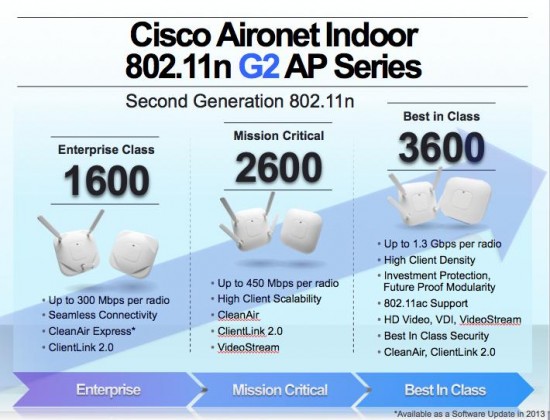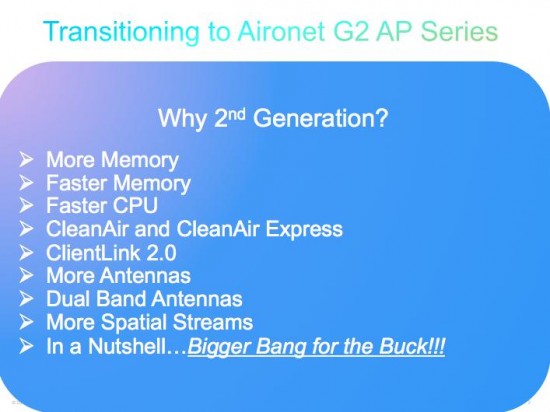
Cisco unveiled the Aironet Access Point 2600 and Aironet Access Point 1600. They join the Aironet Access Point 3600 (launched earlier this year) to make up Cisco’s second generation “G2” enterprise class 802.11n Cisco Aironet Access Points, a key component of Cisco’s Unified Access solution: one network.


The G2 series shares a common hardware and software foundation providing a robust and consistent set of wireless features across all the of the access points. The series was designed to balance feature functionality and price to allow enterprises the ability to target the right access point for their specific location and role within their network.
Where did the impetus for the G2 series come from?
That’s easy: we listened to our customers. We took in our customer stories about what’s impacting their networks today and what they’re planning for the future, all the while keeping a close eye on industry trends. All of this was factored into our G2 series design and development, and I’m proud to say that our products address each of those megatrends and pain points:
- Explosion of Wireless devices connecting to the network – Client Density — BYOD
- Additional memory allowing for an increase in active wireless clients and associated clients
- Help customers stay one step ahead of the growth in the number of wireless devices attaching to their network
- Higher performance clients — Shift to 5 GHz with faster connections
- Value engineering at the radio level working closely with industry chip-set partners, to enhance overall performance beyond standard off-the-shelf chips found in the majority of AP vendors’ products
- ClientLink 2.0 supporting all 802.11n clients (1×1, 2×2, 3×3) providing better overall signal quality and significant downstream throughput
- Ensuring the network is ready with the best performance radios in the industry
- Video growth in the network
- Hardware based quality of service and advanced software architecture that supports unparalleled video scaling within the G2 Access Points, independently verified with Miercom
- Video is increasingly an important part of delivering information within the enterprise, typically for “teaching, training, communicating” to the corporate user base
- Either as canned video or increasingly live streaming, with the later for both streaming live and canned video to users and future growth around bi-directional video e.g. video calls & IMs
- Cloud based networking
- Cloud based networking driving more traffic per user as they access more and more information, applications and participate in designs such as VDI “Thin-Client”
- Key expectations also dove tail with wireless scale and performance
- Leveraging Moore’s law to invest on new high performance CPU’s to be ahead of the curve as the number of clients increases and the amount of traffic continues to grow with them
- Mobility, Mobility, Mobility
- Aside from the fact that the term Mobility means something different to every individual on the planet, the real message here from customers was
- My wireless network needs to always be available, whether stationary or on the go in the same building or between buildings
- I should be able to connect quickly and seamlessly to the network, I don’t want to make allowances for using wireless to conduct my business
- Ensuring the G2 Series scales in the number of clients they support, the overall performance of the AP’s and radios to process client traffic quickly and efficiently allowing the AP’s to handle mobility patterns and time of day density patterns that are typical within all enterprise companies
- Aside from the fact that the term Mobility means something different to every individual on the planet, the real message here from customers was
We are keenly aware that our products serve a whole range of customers, so with G2, we strove for a tiered product approach to allow customers to have the option for choosing the most appropriate G2 series Access Point for their network. Our product tiers are based on “Network Location & Role + AP Functionality + Price Point” to provide customers the most flexibility possible to tackle their networking needs.
| Cisco Aironet 3600 | Cisco Aironet 2600 | Cisco Aironet 1600 | |
| Wi-Fi standards | 802.11 a/b/g/n/ac | 802.11 a/b/g/n | 802.11 a/b/g/n |
| Number of Radios | 2.4 & 5 GHz | 2.4 & 5 GHz | 2.4 & 5 GHz |
| Max Data rate | 1.3 Gbpswith 802.11ac Module | 450 Mbps | 300 Mbps |
| MIMO radio design and spatial streams | 4×4:3 – 802.11n3x3:3 – 802.11ac | 3×4:3 | 3×3:2 |
| # of Associated devices | 200 | 200 | 128 |
| # ofClientLink devices | 128 | 128 | 32 |
With the complete G2 Series of Access made up of the 3600, 2600, and 1600 Aironet access points, Cisco delivers unmatched functionality with tiered pricing that provides customers with the necessary tools and flexibility to design enterprise wireless networks that will support of their needs today and the business needs of tomorrow.
What’s ahead for Aironet Access Points?
The sky’s the limit and this new access layer continues to evolve:
- 802.11ac and higher speeds and feeds
- Access Point as the primary connection point back into the wired network for more and more network services
- Fine grained traffic awareness and intelligent switching
- Next generation per user per device context awareness
- And of course ever increasing amount of traffic from more and more wireless devices
Stay tuned…
For more information on all Wireless Access points, check out the complete range of G2 Series Access Points.
News from https://blogs.cisco.com/wireless/cisco-ushers-in-the-next-generation-in-enterprise-class-wi-fi-connectivity/
More Cisco Aironet Access Point Tips & News:
What You Should Pay Attention to Cisco Aironet Access Point While Purchasing?
Antenna Product Portfolio for Cisco Aironet 802.11n Access Points
Wireless Network: How to Configure Wireless Security?
Cisco’s New Aironet Wireless Access Points Make Networks Faster and Steadier


